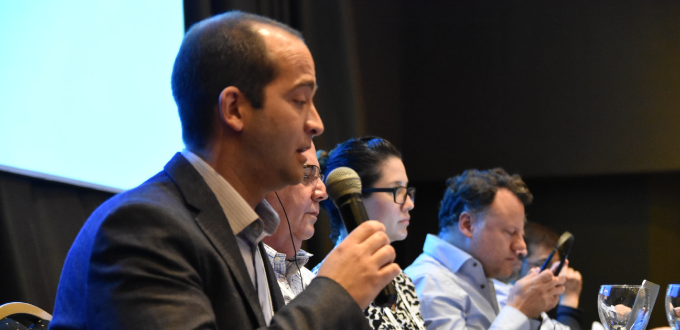Success Stories in IPv4 Address Transfers
31/10/2018

LACNIC organized a panel to discuss the current status of IPv4 resource transfers in Latin America and the Caribbean and the experiences of three other regions (ARIN, APNIC and RIPE) that allow transferring IP addresses between different Regional Internet Registries (RIRs).
Alfredo Verderosa, Chief Services Officer at LACNIC, observed that the purpose of the meeting was to respond to community concerns regarding IPv4 resource transfers.
“For some time now, we have been receiving frequent questions from the community about what the transfer process involves, where they can obtain IPv4 addresses, how many transfers have been made in the region, and many others. Because of this, we tried to offer the community relevant information about what is going on in the LACNIC region as well as in the other RIRs, and recommendations to support to those who are thinking of participating in these processes,” said Verderosa during his opening of the panel in Rosario, Argentina.
Panelists included the directors for registration services at the three RIRs that allow transfers as well as representatives of two organizations (IPbroker and Addrex) that have been facilitating transfers for years.
Presenters addressed different aspects relevant to those who are thinking of transferring IPv4 address blocks.
Since the community enabled this possibility back in March 2016, twenty IPv4 transfers have taken place in the LACNIC region, informed Sergio Rojas, Registration Service Specialist at LACNIC. The transferred blocks represent approximately 192,512 IPv4 addresses.
Currently, LACNIC started offering a new tool through its Mi LACNIC service, where three lists have been included: a list of those potentially interested in transferring IPv4 addresses, a list of those interested in acquiring these resources, and a list of organizations that serve as facilitators.
Available to all. John Sweeting, Senior Director for Registration Services at ARIN, noted that in his region there has been an increase in the number of low-volume transfer operations which can be attributed to new market entrants. According to Sweeting, “Transfers in the ARIN region are increasing, but this does not directly translate to number of IP addresses transferred, a sign that smaller ISPs are entering the market.”
Sweeting added that inter-RIR transfers are a “win-win” for ARIN: while the overall space managed by this registry decreased by approximately 14 million IPv4 addresses from 2016 to present due to inter-RIR transfers, the overall space issued by ARIN increased by more than 30 million addresses primarily due to the conversion of legacy space via intra-regional transfers.
ARIN currently has a large amount of legacy space available to ARIN, APNIC and RIPE NCC customers through inter-RIR transfer policies.
He suggested that the small number of transfers in the LACNIC region could be due to the lack of idle resources (legacy space in the LACNIC inventory is about 5 million addresses, little more than one /10), while ARIN does have legacy resources in its inventory (40 /8s of legacy space at ARIN, four times the entire space assigned to the LACNIC region). Legacy space at ARIN is 130 times greater than in the LACNIC region.
At ARIN, they see transfers as a win-win situation: transfers allow resources that are not being used —legacy resources— to return to the system, making available new space for which users must pay.
In turn, Andrea Cima of RIPE, shared recommendations for successful transfers and highlighted the importance of keeping up-to-date contact information to avoid transfer-related fraud. In this regard, he noted that RIPE offers an IPv4 Transfer Listing Service to facilitate supply and demand, thus increasing transparency, and publishes a list of recognized facilitators that have agreed to follow the policies and procedures established by RIPE. Cima, however, made it clear that RIPE plays no part in transfer-related financial agreements or transactions.
George Kuo, Services Director at APNIC, then shared that the trend in transfers has remained stable since 2014, with the RIR processing about 30 to 40 transfers per month. He noted that most of the inter-RIR market transfers come from the ARIN region, and added that, as of July 2018, approximately 17.8 million IPv4 addresses had been transferred to APNIC, while only 384 thousand addresses had been transferred outside their region.
On the same path. Nacho Mateo of IPbroker commented that the facilitator’s role in IPv4 address transfers is to provide both the receiving and the offering organizations with the necessary information and explain the available mechanisms so that they can complete the transfer with every possible guarantee.
While noting that it was not his intention to meddle in the internal matters of the LACNIC community, Mateo observed that, in the short and medium term, the IPv4 address needs of ISPs in the LACNIC region will be similar to those of ISPs in other RIRs. As an example, he noted that there are as many transfers in the LACNIC region in a year as there are in the other RIRs in a day. “It is important to find solutions,” he added.
According to Mateo, the LACNIC region would benefit from an inter-RIR transfer policy that allows bidirectional IP address transfers among the different RIRs.
The facilitator believes that, as long as an inter-RIR transfer policy is not implemented, the price of IPv4 addresses will only increase and will only benefit those offering addresses for transfer.
In closing the panel, LACNIC’s CSO stressed that the RIR will continue to work to make sure that the Latin American and Caribbean community has the necessary information on this topic. He also added that if any person or organization has any questions or concerns regarding IP transfers, or if they would like to propose a transfer policy, they should write to transferencias@lacnic.net or politicas@lacnic.net
Click here to watch the entire panel.
(Free access, no subscription required)